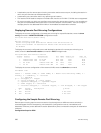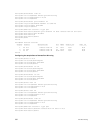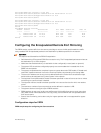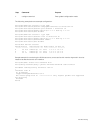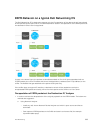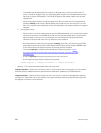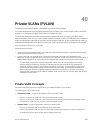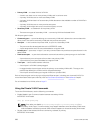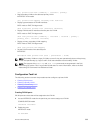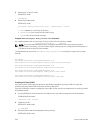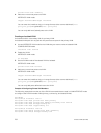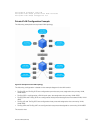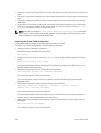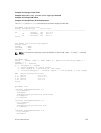
• Primary VLAN — the base VLAN of a PVLAN:
– A switch can have one or more primary VLANs, and it can have none.
– A primary VLAN has one or more secondary VLANs.
– A primary VLAN and each of its secondary VLANs decrement the available number of VLAN IDs in
the switch.
– A primary VLAN has one or more promiscuous ports.
– A primary VLAN might have one or more trunk ports, or none.
• Secondary VLAN — a subdomain of the primary VLAN.
– There are two types of secondary VLAN — community VLAN and isolated VLAN.
PVLAN port types include:
• Community port — a port that belongs to a community VLAN and is allowed to communicate with
other ports in the same community VLAN and with promiscuous ports.
• Host port — in the context of a private VLAN, is a port in a secondary VLAN:
– The port must first be assigned that role in INTERFACE mode.
– A port assigned the host role cannot be added to a regular VLAN.
• Isolated port — a port that, in Layer 2, can only communicate with promiscuous ports that are in the
same PVLAN.
• Promiscuous port — a port that is allowed to communicate with any other port type in the PVLAN:
– A promiscuous port can be part of more than one primary VLAN.
– A promiscuous port cannot be added to a regular VLAN.
• Trunk port — carries traffic between switches:
– A trunk port in a PVLAN is always tagged.
– In tagged mode, the trunk port carries the primary or secondary VLAN traffic. The tag on the
packet helps identify the VLAN to which the packet belongs.
– A trunk port can also belong to a regular VLAN (non-private VLAN).
Each of the port types can be any type of physical Ethernet port, including port channels (LAGs). For
more information about port channels, refer to Port Channel Interfaces in theInterfaces chapter.
For an introduction to VLANs, refer to Layer 2.
Using the Private VLAN Commands
To use the PVLAN feature, use the following commands.
• Enable/disable Layer 3 communication between secondary VLANs.
INTERFACE VLAN mode
[no] ip local-proxy-arp
NOTE: Even after you disable ip-local-proxy-arp (no ip-local-proxy-arp) in a
secondary VLAN, Layer 3 communication may happen between some secondary VLAN hosts,
until the address resolution protocol (ARP) timeout happens on those secondary VLAN hosts.
• Set the mode of the selected VLAN to community, isolated, or primary.
INTERFACE VLAN mode
698
Private VLANs (PVLAN)



